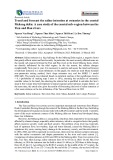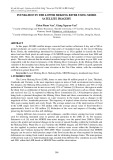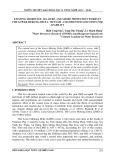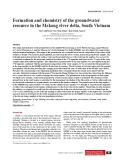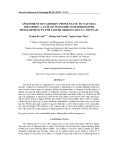
The lower mekong delta
-
Saline intrusion is a big challenge for the Mekong Delta region, a negative factor that greatly affects water and food security. In particular, the most severely affected areas are the coastal sub–regions between the Tien and Hau rivers in the lower Mekong basin, which are directly influenced by the tidal regime.
 10p
10p  viironman
viironman
 02-06-2023
02-06-2023
 12
12
 3
3
 Download
Download
-
Agricultural wastes can be converted into biofuels. To meet the requirements of biofuels, the conditions of their manufacturing process for these products must be considered. The purpose of this research is to optimize experimental designs for converting biomass into energy products like pyrolysis and pelleting process. The products were optimized in terms of their energy performance while lowering CO2 emissions.
 10p
10p  vicedric
vicedric
 08-02-2023
08-02-2023
 1
1
 1
1
 Download
Download
-
The Mekong Delta is a key rice development area of the country, but the region also faces many challenges. Growing rice brings lower efficiency to farmers than other crops on the same area. The government has a policy to allow households to switch from rice-growing land to other crops.
 12p
12p  visherylsandberg
visherylsandberg
 18-05-2022
18-05-2022
 4
4
 1
1
 Download
Download
-
In this paper, MODIS satellite images corrected land surface reflectance 8-day and at 500 m spatial resolution are used to produce the time-series of inundated maps in the Lower Mekong River
 4p
4p  viwendy2711
viwendy2711
 05-10-2021
05-10-2021
 12
12
 1
1
 Download
Download
-
Researchers agree that the main reason for these consequences are the lack of sediment deposited in MD due to the absence of floods and upstream hydropower development.
 6p
6p  nat_qb73
nat_qb73
 21-02-2021
21-02-2021
 10
10
 2
2
 Download
Download
-
The coastal area of the Lower Mekong Delta (LMD) is influenced by waves, tidal currents, changing sediment loads from the Mekong, and Sai Gon-Dong Nai rivers, and storm surges from the East and West Sea.
 12p
12p  lucastanguyen
lucastanguyen
 01-06-2020
01-06-2020
 13
13
 3
3
 Download
Download
-
The study was performed with completely randomized factorial design having in triplicate. The experiment was carried out at the College of Environment and Natural Resources of Can Tho University from July to November 2018. Morphological toxic symptoms and growth inhibition were clearly observed in salt-treated treatments. Among the four studied species, T. orientalis produced the highest dry shoot biomass (15.5 g DW/plant), while E. dulcis had the lowest value (2.8 g DW/plant). However, only T. orientalis showed significantly decreased in biomass as salinity increased with 9.3 and 4.
 9p
9p  angicungduoc5
angicungduoc5
 13-06-2020
13-06-2020
 30
30
 1
1
 Download
Download
-
The origin and chemistry of the groundwater in the middle Pleistocene (qp2 3 ), lower Pleistocene (qp1 ), upper Pliocene (n2 2 ), lower Pliocene (n2 1 ), and the Miocene (n1 3 ) in the Mekong river delta (MKRD) were investigated by using isotopic and geochemical techniques. The origin of the groundwater was evaluated based on the composition of the water stable isotopes (d2 H and d18O) in the local precipitation, in water from the rivers system, and in the groundwater samples.
 11p
11p  caygaocaolon1
caygaocaolon1
 13-11-2019
13-11-2019
 11
11
 0
0
 Download
Download
-
The study provides a comprehensive view at the prone state of the Mekong Delta under baseline conditions of hydropower development. Communities in Vietnam Mekong Delta have main income sources from rice farming, fishing and aquaculture, so changes in floods pattern or salinity can directly affect people’s livelihoods.
 8p
8p  cumeo3000
cumeo3000
 01-08-2018
01-08-2018
 20
20
 0
0
 Download
Download
-
Abstract. In this study, we assessed the impact of sea level rise, one of the most ascertained consequences of global climate change, for water levels in the Vietnamese Mekong Delta (VMD). We used a hydraulic model to compute water levels from August to November – when flooding is presently critical – under sea level rise scenarios of 20 cm (= 20) and 45
 19p
19p  nguyenngocsonctu
nguyenngocsonctu
 05-12-2010
05-12-2010
 95
95
 24
24
 Download
Download
-
Since 2000, the shrimp industry expands at a fast rate in the coastal areas of the Mekong Delta, Vietnam. Shrimp farming is known for its negative impact on the coastal environment. However, other human interventions like agriculture and urbanization also deteriorate the coastal environment. The land cover changes between 1968 and 2003 were determined and analyzed for the Cai Nuoc district, Ca Mau Province, Vietnam, using photos from 1968, 1992 (aerial photographs), 1997/98 (Spot) and 2003 (Landsat).
 18p
18p  nguyenngocsonctu
nguyenngocsonctu
 05-12-2010
05-12-2010
 121
121
 7
7
 Download
Download
-
An outstanding feature of the lower Mekong region is the dynamic energy of its natural systems and how intimately tied most of the population is to that seasonal force. Productivity in agriculture and fisheries, for example, depends on annual floodplain inundation and nutrient dispersal. The immense scale and impact of this natural cycle is well illustrated in the annual flooding of Tonle Sap Lake in Cambodia and the Mekong River Delta which it shares with Vietnam.
 199p
199p  nguyenngocsonctu
nguyenngocsonctu
 02-12-2010
02-12-2010
 111
111
 16
16
 Download
Download
-
Vietnam is embarking on a path towards a knowledge-based economy in which the emergence of knowledge clusters in Ho Chi Minh City and the Mekong Delta are playing a decisive role. As our paper suggests, clustering appears to have a positive effect not only on the increase of knowledge output, but also on the economic growth of these regions. Using a GIS-based mapping method, we can identify two major knowledge clusters – Ho Chi Minh City and Can Tho City.
 24p
24p  nguyenngocsonctu
nguyenngocsonctu
 02-12-2010
02-12-2010
 105
105
 6
6
 Download
Download
-
This paper is the result collaborative work between international and riparian biologists and ecologists over a number of years. The principal contributing authors are: Yuwadee Peerapornpisal, Tatporn Kunpradid, Sutthawan Suphan, (benthic diatoms); Chanda Vongsambath, Niane Sivongxay (littoral macroinvertebrates); Pham Anh Duc (benthic macroinvertebrates); Nguyen Thi Mai Linh (zooplankton); Supatra Parnrong Davidson, Sok Khom, and Monyrak Meng (environmental variables).
 100p
100p  nguyenngocsonctu
nguyenngocsonctu
 01-12-2010
01-12-2010
 134
134
 20
20
 Download
Download
-
Water quality is one of the key factors affecting the environmental health of the Mekong river system. As the livelihoods of most of the 60 million people who live in the Lower Mekong Basin (LMB) wholly or partly depend on aquatic resources, the environmental health of the river is a major concern to the governments of the countries in the basin. In 1985, the Mekong River Commission (MRC) established the Water Quality Monitoring Network (WQMN) to provide an ongoing record of the water quality of the river, its major tributaries, and the Mekong Delta.
 90p
90p  nguyenngocsonctu
nguyenngocsonctu
 01-12-2010
01-12-2010
 144
144
 24
24
 Download
Download
-
The Songkhram River is a large tributary of the Mekong River which runs through the northern part of northeast Thailand. The river system supports a large but previously undescribed capture fi shery. This survey covered villages within the lower one-third of the Songkhram River Basin (SRB), where extensive wetlands are associated with the most productive fi sheries.
 110p
110p  nguyenngocsonctu
nguyenngocsonctu
 01-12-2010
01-12-2010
 71
71
 12
12
 Download
Download
-
The Mekong River system supports one of the world’s largest and most diverse inland fisheries. It includes a broad assortment of operations, ranging from solitary fishers to largescale commercial enterprises. The catch contains a high proportion of fishes whose lifecycles involve migrations between feeding and spawning grounds and dry season refuges. The preservation of the river’s fisheries, therefore, partly depends on keeping the migration routes these fish use free from obstructions and barriers that could critically disrupt their lifecycles.
 0p
0p  nguyenngocsonctu
nguyenngocsonctu
 01-12-2010
01-12-2010
 97
97
 8
8
 Download
Download
-
The fishery of the Mekong River is one of the largest and most significant in the world, and most of the production is based on migratory river fishes. An earlier report provided an overview of the general patterns of fish migrations and their significance for management. This complementary report provides more detailed information on 40 key species which are significant in the Mekong River fishery. For each species we provide notes on distribution, feeding, size, population structure, critical habitats, life cycle and its importance in fisheries.
 116p
116p  nguyenngocsonctu
nguyenngocsonctu
 01-12-2010
01-12-2010
 160
160
 20
20
 Download
Download
-
BackGround Balanced, equitable and sustainable development of the fisheries sector must take all social groups into account. However, the role of women in the sector has, for a long time, gone unrecognised and their voice is heard rarely among managers, policy makers and legislators.1 The lack of recognition and representation is not only unfair, but it also leads to an incomplete understanding of how the sector as a whole operates and functions.
 8p
8p  nguyenngocsonctu
nguyenngocsonctu
 01-12-2010
01-12-2010
 90
90
 4
4
 Download
Download
-
Water is possible our most precious natural resources. Abundance and quality of water drivers all human systems and those of most other organisms as well (Isobel W.Hathcote, 1998).
 7p
7p  hoangdung
hoangdung
 15-03-2009
15-03-2009
 166
166
 25
25
 Download
Download
CHỦ ĐỀ BẠN MUỐN TÌM








